한식 읽기 좋은 날
Vol 28. Bokbunja & Subak - Jeolla-do
Sogeum, Ganjang and Ssal
Writing. Photo-Lee Youngmi, Public Art Critic, Author of
Hansik glossary
Sogeum - Salt
Ganjang - Soy Sauce
Ssal - Rice
Sogeum, Ganjang and Ssal
Writing. Photo-Lee Youngmi, Public Art Critic, Author of <Great Ingredients>
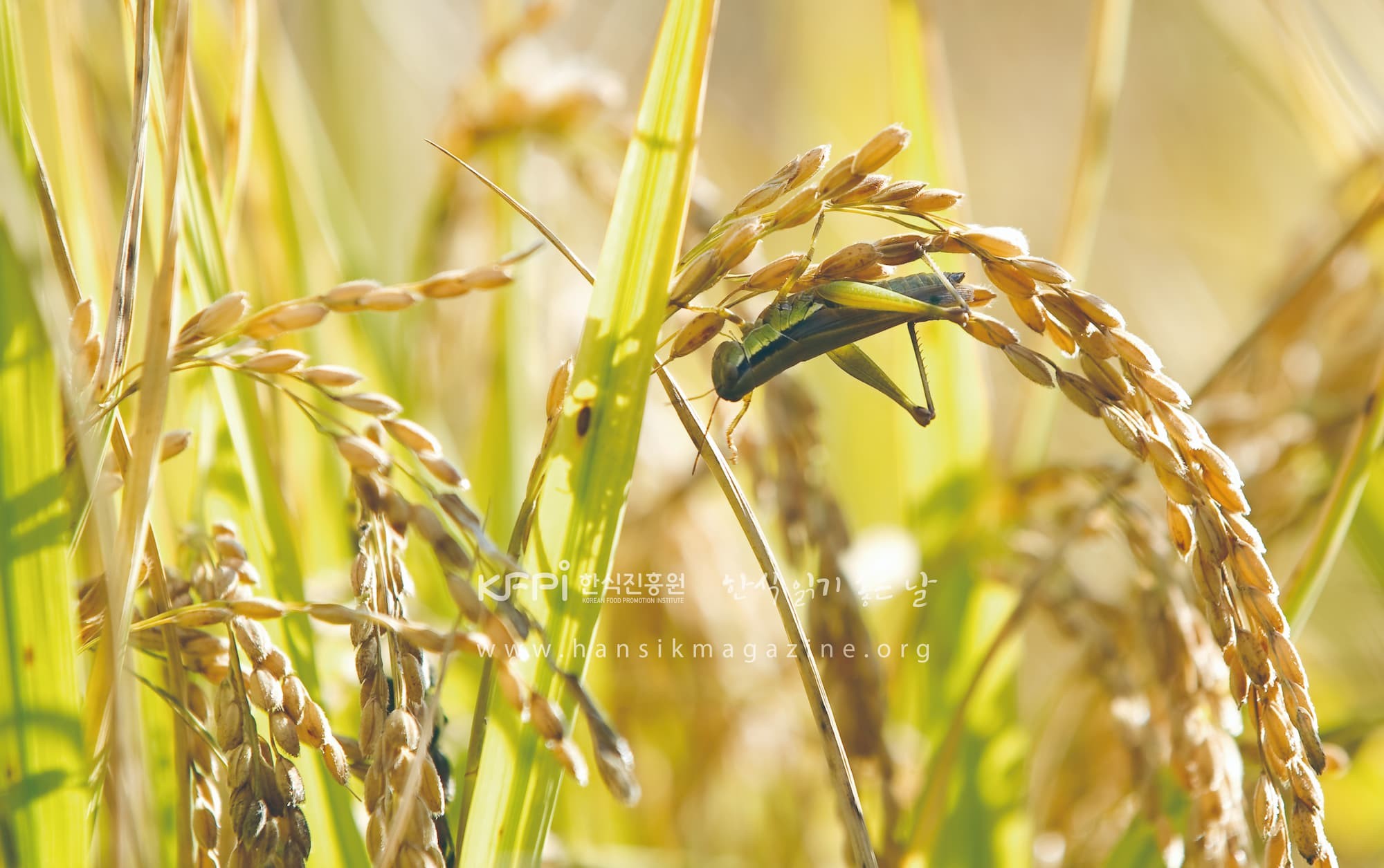
The rice grains bowed down are elegant like an orchid in the Oriental painting, and the grainy texture of the rice grains is hard like a bamboo leaf. Grasshoppers are running and jumping while pecking around pesticide-free rice.
Photo ⓒ Great ingredients, Mineumsa, Park Jonggeun(JoongAng Ilbo)
Somehow I published three books on food and ingredients, but I am reluctant to be called a food critic. I don't take food culture as the domain of my job, and of course, I hope that what I say about it is not misunderstood as the expert's authoritative story. The reason why the non-professional was entrusted with a fixed column space in a weekly or daily journal was probably that I liked to explain logically about a specific object with a habit of research and criticism. One more thing may be that the obsession with food seemed somewhat extraordinary. Making kimchi from the mid 20's just married, making the sauce from the early 30's, often picking raw anchovy or yellowfish, salting the salted fish, enjoying the rice rather than eating out, but there is no electric rice cooker in the house, and passing by 1+1' sale products at the market but carefully reading the list of raw materials and food additives printed like small grains on the back of processed food packaging. It is partly true that I am a person with a special obsession with eating.
The most important thing to me is the basic ingredients. Things like ssal(rice) and sogeum(salt), jang(sauce), jeotgal(salted fish), and fresh vegetables. Among them, ssal and sogeum should be selected when selecting the key ingredients. In fact, grain and sogeum are the basics of the basics in any culture. It may be because the human body is made of them. Grain supplies carbohydrates to fill calories and sogeum is a basic food that normalizes body fluids. If I add one more, I will say water. With these three things: grain, sogeum, and water, a person can survive for a considerable period of time.
The debates about salt, but a taste that can never give up

After the salt is pushed out, the salty bottom is exposed.
The salt, crystalized by revealing the traces of water bleeding over black clay, was as mysterious as seeing the stars in the universe.
Photo ⓒ Kwon Hyukjae, Great ingredients, Mineumsa
I am still a bit cautious of talking about sogeum. It is because there has been quite a heated debate between the sun-dried sogeum producers and famous food critics. As a non-professional, I don't have the ability to discuss who is right or wrong in the opinions of conflicting experts, I can only put a few words in my experience and common sense.
For the claim that it is right to eat refined sogeum (it is extracted with only the sogeum component by refining sun-dried sogeum, particles are small like sugar) because the sun-dried sogeum is not so clean, I am half acceptable and half unacceptable. It is not easy to deny the claim that the seawater off the coast of Korea is not so clean and that the sun-dried sogeum made by drying the seawater is also not clean. In fact, if you dissolve the sun-dried sogeum in water, there found quite a few impurities. If you insist on sun-dried sogeum because of minerals, it is also right to say that it is better to supplement minerals with other foods.
The problem is that it is very difficult to eat food with refined sogeum from which impurities have been removed. If you cook food with a very sogeum, only sogeum taste, refined sogem, it is not difficult to match the saltiness of the food. When I'm cooking, I'm a person who uses ganjang more than sogeum, but sometimes I have to do it with sogeum. For the food with clean taste such as gomtang(beef bone soup), kongnamulguk(bean sprout soup), kongguksu(noodles in cold soybean soup), gyeranjjim(steamed eggs), and jogaetang(clam soup). The clean taste should be seasoned with sogeum rather than ganjang. By the way, if I use refined sogeum, I will say that only salty taste will hit my tongue compared to using sun-dried sogeum. Adding sogeum does not have the effect of mixing various flavors of ingredients. So, considering it is not seasoned well, I want to add more sogeum, or mix the flavor with the strong flavor of the chemical seasoning. It is difficult to give up sun-dried sogeum because of the taste, not the nutrients.
Mud flooring sogeum and Vinyl flooring sogeum
So, I had no choice but to find a clean and good sun-dried sogeum. Then, I came to know the 'mud flooring sogeum 土版鹽'. When I knew what I looked for was the mud flooring sogeum, I realized that the sogeum I had been taking was 'vinyl flooring sogeum'. As vinyl was mass-produced in the middle of the 20th century, even in salt ponds, the method of laying black vinyl on mudflats and making sogeum on it became popular. When scrapping sogeum in the salt pond, the bottom soil was not mixed so that producing clean sogeum became easier.
The problem, however, is that the soil under the floor is impermeable. The odor of the salt ponds pointed out by the critics who raised the sun-dried sogeum infection problem is most likely due to the lack of air ventilation through the floor. In addition, it is naturally doubtful whether there will be no harmful substances from the black vinyl in the sultry midsummer, and whether the vinyl used for many years will be broken and mixed.
A few decades ago, some salt ponds dared to revive the old way of producing sogeum on the mudflats by removing vinyl. The mud flooring sogeum has been resurrected. The mud flooring sogeum, which was tasted after going to Sinan, was definitely mysteriously delicious. It was easier to season food suitable for my taste. The problem is the price. As only the sogeum on the surface needs to be scrapped, it requires skilled labor and is expensive. Still, it's not easy to go back to use the vinyl flooring sogeum once you upgrade your taste. Even if you use the vinyl flooring sogeum to pickle kimchi, sogeum for cooking, which is not consumed much, shall be the mud flooring sogeum. My picky and demanding taste is a 'mortal enemy'.

Scrapping sogeum on the vinyl flooring pot is a difficult task.
You should push the heavy scraper gently so that the mud at the bottom should not rise.
Photo ⓒ Great ingredients, Mineumsa, Kwon Hyukjae
Ganjang, seasoning with savory taste and unique flavor
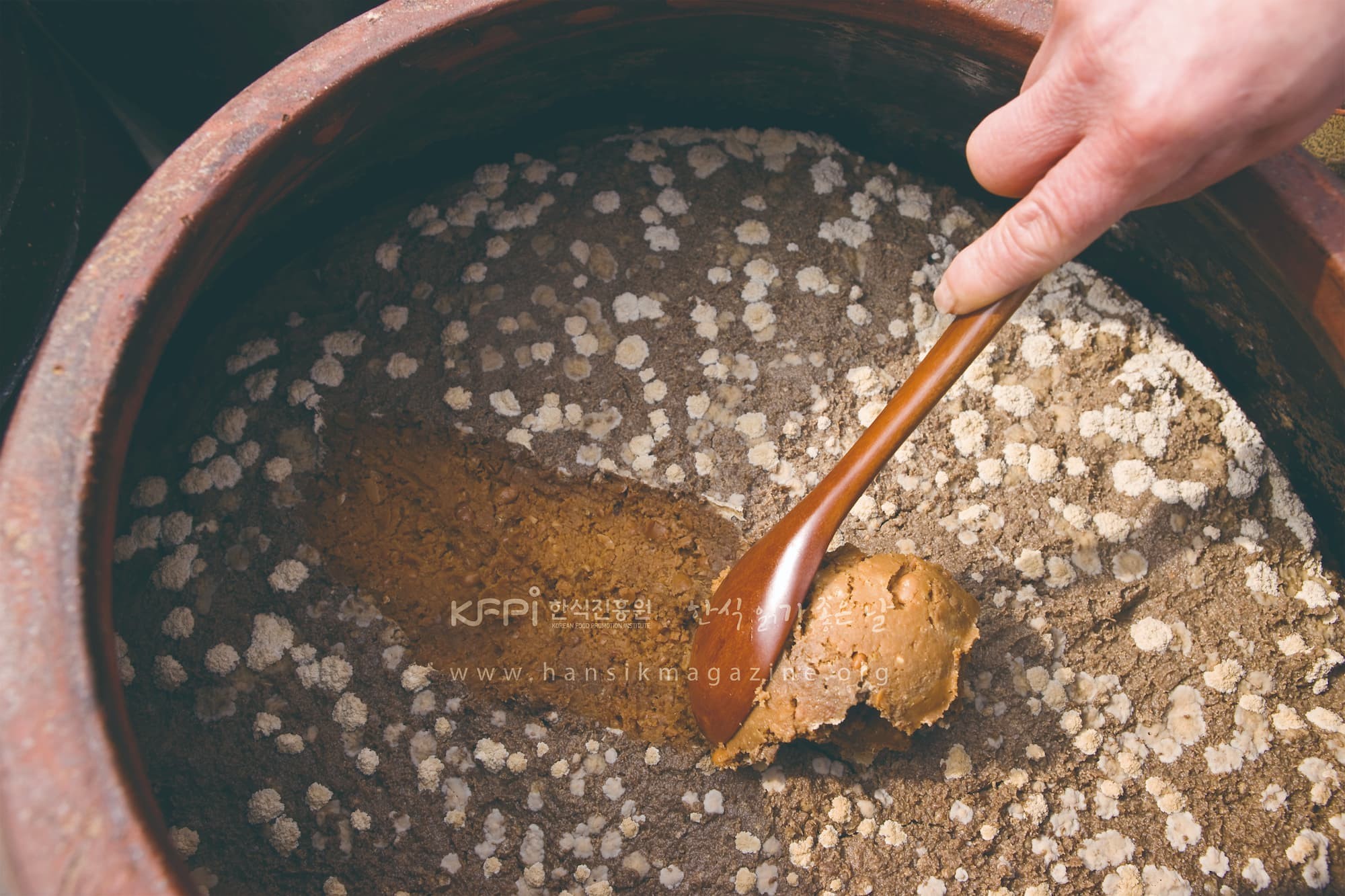
Soybean paste made in a pervious year. Removing white Eurotium from the surface, well-made yellow soybean paste pops out. The more it is preserved, the darker color will be, however, its taste and flavor becomes deeper and deeper.
Photo ⓒ Great ingredients, Mineumsa, Kwon,Hyukjae
The reason I could boldly change the sogeum was that I didn't consume much anyway. I tend to use ganjang(soy sauce) more than sogeum when cooking. Most of the food, except for the few listed above, is seasoned with ganjang. At the age of only thirty, despite my mother's nagging to eat as much as I could, I insist that I would make it with my own hands as I was worried about how long my mother would be able to give me ganjang. I wanted to ‘declare the independence of soy 'ganjang’ from my mom when I was younger even a single year.
Here, the term “ganjang” means “Joseonganjang”, "jibganjang”, and “gukganjang” made from traditional fermented soybean lump, not factory-made ganjang sold at ordinary markets. (The factory-made ganjang is called 'waeganjang' for a long time because Japanese soy sauce was introduced and settled during the Japanese colonial regime, and the traditional soy sauce made with fermented soybean lump at home was called 'Joseonganjang.') There are also cases that the factory-made ganjang are required for cooking bulgogi or braised fish, however, I put Joseonganjang in all kinds of soups and mixed vegetables instead of sogeum. In a way, ganjang is used as a seasoning for saltiness more than sogeum.
If the sogeum is only for the salty taste, ganjang is a seasoning that adds the savory taste and unique flavor of fermented soy protein. For the savory taste, jeotgal which is adding sogeum to seafood and fermented is the better way, but even if it is made neatly like ‘eo(魚)ganjang’, it is difficult to completely remove the fishy smell. Even if miyeokguk(seaweed soup) or bugeotguk(dried pollack soup) is replaced by salted seafood, it is difficult to use salted seafood for sogogimutguk(beef and radish soup) or all kinds of namul(vegetables salad).
Subtly diverse taste, traditional ganjang
As soon as I passed the age of thirty, one day in January of the lunar calendar, I took a lump of fermented soybean from my mother as if I robbed of it and put it into a very small jar with saltwater. In early April, the fermented soybean lump was taken out and I boiled raw ganjang, and the dredged(fermented soybean) lump was crushed and put into another jar preserved for two winters. Those are my first ganjang and soybean paste cooked, of which the result was successful. With fermented soybean lump, I found that making ganjang and soybean paste is really easy and simple. It's already been 30 years ago, and unlike that time, there are many small companies selling Joseonganjang in the country. You can easily find it from a Consumers's co-operative or the Internet, not a large market.
Interestingly, unlike factory-made ganjang, these traditional ganjang have different tastes between companies. Delicious know-how is also slightly different. The know-how and hand taste of the “mothers” responsible for the taste of each small company, such as the amount of sogeum and the place and period of fermentation, make the subtle difference. If you gather all of these people and have a discussion, it will make a great debate, but it is not necessarily who is right. It is natural in a culture that there are so many non-standardized “Our Mom's Ganjang” across the country.
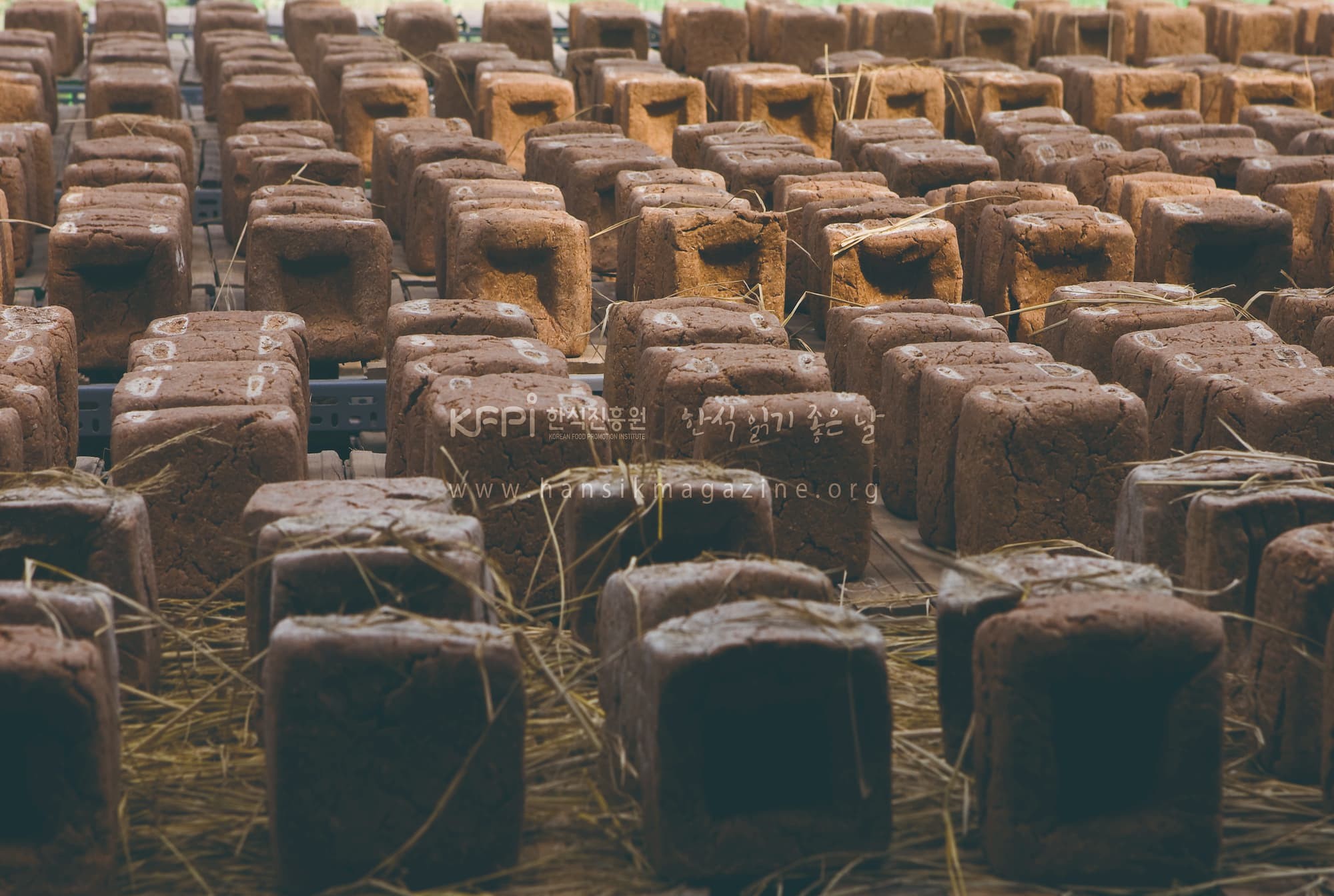
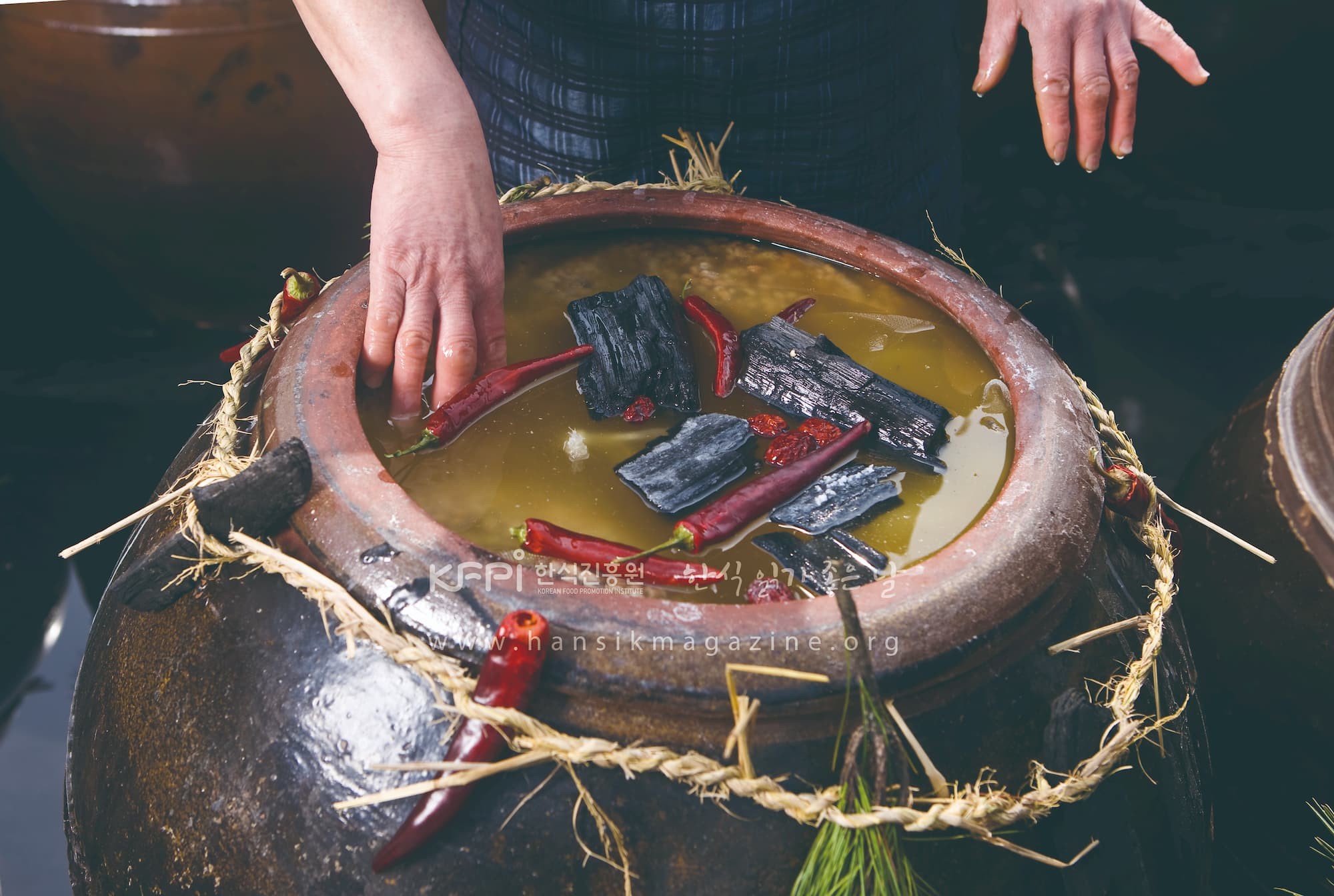
Fermented soybean lump, which is slowly and naturally
fermented for three or four months with rice straw
layered under in the traditional way.
The deep taste starts here.
Photo ⓒ Great ingredients, Mineumsa, Kown Hyukjae
If you add fermented soybean lump and saltwater to the jar and put charcoal and pepper on it, making ganjang is done.
Photo ⓒ Great ingredients, Minuemsa, Kwon Hyukjae
Rice is soft that you don't have to use a pressure cooker
I am often asked a question about which Rice(ssal) to buy. But my answer is surprisingly simple. I just buy the organic brown rice from my back-to-earth acquaintance. Even without the friend, I may just choose organic brown rice from the cooperative. The uniqueness of the rice I cook depends not on the choice of rice, but on other reasons. One is polishing and the other is a pot. I buy brown rice and polish it home. It's been about 20 years since I used a small household polisher. It is a method to polish a little doze of rice I cook to eat and cook it immediately. So, even in the late summer, the flavor of steamed rice is so fresh - not much different from new crops.
The reason to do such a picky thing was the result of going to and fro between brown rice and white rice. My husband insisted on brown rice for health reasons, but I had a weak stomach so that I was a bit burdened with brown rice. Even if rice was soaked for a long time and even though it was cooked in a pressure cooker, the rough outer skin made me uncomfortable. So, after eating brown rice for a while, I used to return to white rice.
Then, I happened to know there was a household polishing machine and I bought it. Since I have a polishing machine, I could choose from 1st degree to 9th degree at my will. The product that sells as healthy rice with rice eyes is usually 5th-degree one, but only 2nd or 3rd-degree ones with just a little peel-off the outer skin was cooked to the soft extent that the rice can't be compared with brown rice. Nutritious rice eyes and brown rice have a lot of savory flavors kept, so it takes full advantage of brown rice and white rice.
The rice is soft that I don't have to use a pressure cooker. The pressure cooker made the stickiness of rice stronger, but the degree of stickiness is a bit excessive, and the rice becomes chewy. However, if you cook rice in a regular electric rice cooker, which is similar to pot rice, it will be overly greasy. The best thing is a cast iron pot. There is a decent reason in the catchphrase of the advertisement for all kinds of electric rice cookers as a ‘cast iron rice flavor’. The most important thing is the proper pressure generated by the weight of the heavy pot cover. Proper stickiness occurs that is not as light as from a pot and not excessive from a pressure cooker. A 3,4 serving small and cute iron pot that I bought at an event market is the most important cookware in my kitchen. What is something more important than rice?
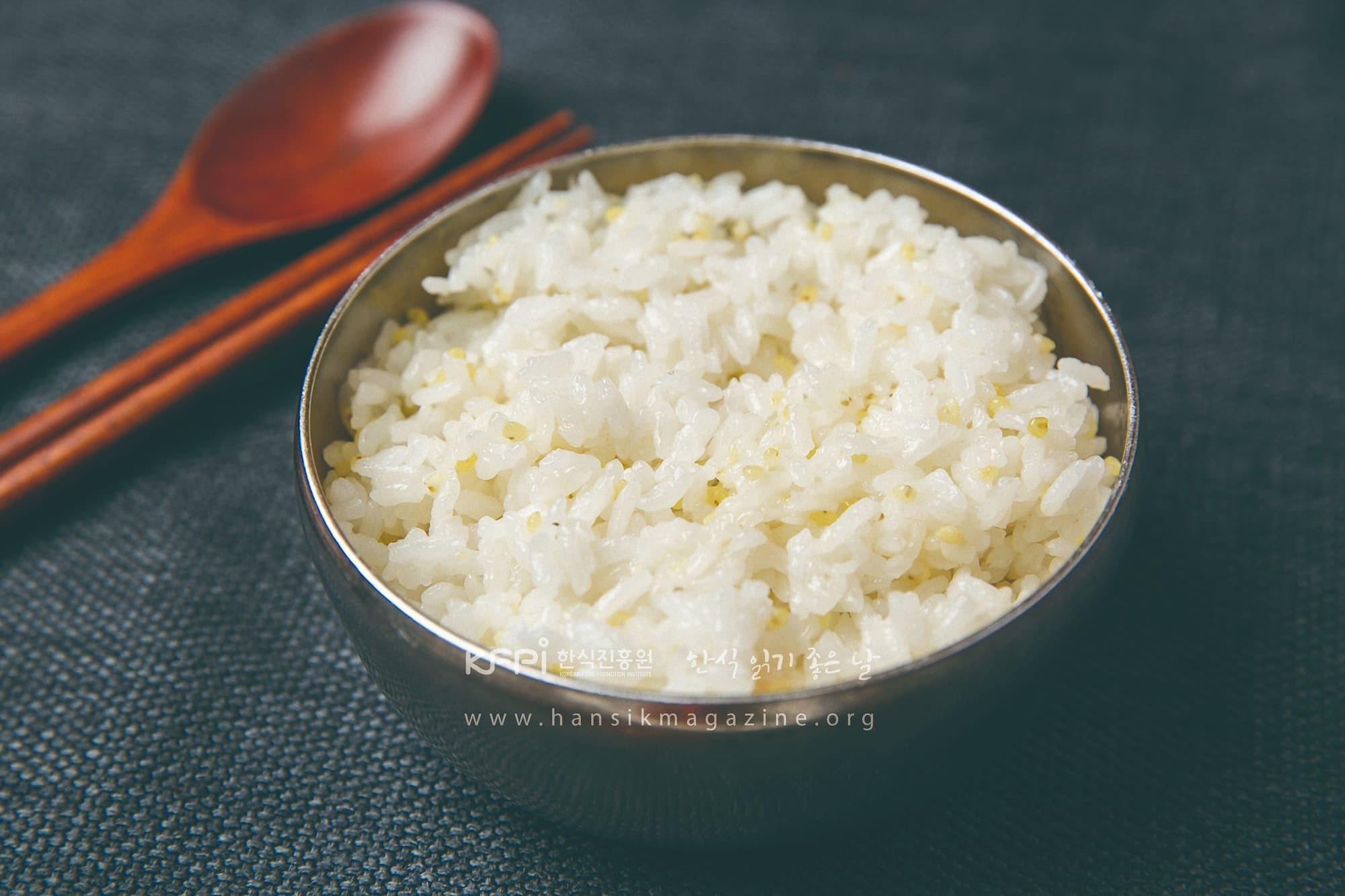

How can you describe the attractiveness of rice shiny and moderately sticky?
The effort to find delicious and healthy rice is extremely natural.
Photo ⓒ Great ingredients, Minuemsa, Kwon Hyukjae
This article is in the writer's opinion only and may differ from the official opinion of <Korean Food Promotion Institute>.
Lee Youngmi
Pop art critic and researcher. Since she was in her 30s, she started to grow her own garden eating seasonal food, and became interested in food and ingredients. Her books related to food include <The Story of Our nice and simple Dining Table written by all-rounder Lee, Youngmi>, <The Seasonal Table for Me>, and <Great Ingredients> etc.










